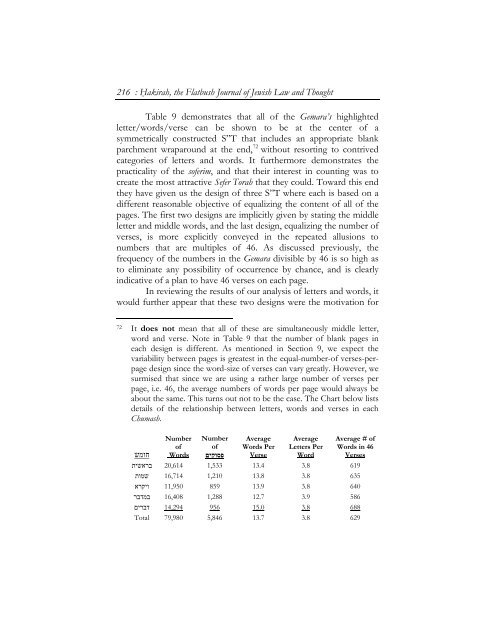Symmetrically Designed Sifrei Torah: A Quantitative Analysis - Hakirah
Symmetrically Designed Sifrei Torah: A Quantitative Analysis - Hakirah
Symmetrically Designed Sifrei Torah: A Quantitative Analysis - Hakirah
You also want an ePaper? Increase the reach of your titles
YUMPU automatically turns print PDFs into web optimized ePapers that Google loves.
216 : Hạkirah, the Flatbush Journal of Jewish Law and Thought<br />
Table 9 demonstrates that all of the Gemara’s highlighted<br />
letter/words/verse can be shown to be at the center of a<br />
symmetrically constructed S”T that includes an appropriate blank<br />
parchment wraparound at the end, 72 without resorting to contrived<br />
categories of letters and words. It furthermore demonstrates the<br />
practicality of the soferim, and that their interest in counting was to<br />
create the most attractive Sefer <strong>Torah</strong> that they could. Toward this end<br />
they have given us the design of three S”T where each is based on a<br />
different reasonable objective of equalizing the content of all of the<br />
pages. The first two designs are implicitly given by stating the middle<br />
letter and middle words, and the last design, equalizing the number of<br />
verses, is more explicitly conveyed in the repeated allusions to<br />
numbers that are multiples of 46. As discussed previously, the<br />
frequency of the numbers in the Gemara divisible by 46 is so high as<br />
to eliminate any possibility of occurrence by chance, and is clearly<br />
indicative of a plan to have 46 verses on each page.<br />
In reviewing the results of our analysis of letters and words, it<br />
would further appear that these two designs were the motivation for<br />
72 It does not mean that all of these are simultaneously middle letter,<br />
word and verse. Note in Table 9 that the number of blank pages in<br />
each design is different. As mentioned in Section 9, we expect the<br />
variability between pages is greatest in the equal-number-of verses-perpage<br />
design since the word-size of verses can vary greatly. However, we<br />
surmised that since we are using a rather large number of verses per<br />
page, i.e. 46, the average numbers of words per page would always be<br />
about the same. This turns out not to be the case. The Chart below lists<br />
details of the relationship between letters, words and verses in each<br />
Chumash.<br />
חומש<br />
Number<br />
of<br />
Words<br />
Number<br />
of<br />
פסוקים<br />
Average<br />
Words Per<br />
Verse<br />
Average<br />
Letters Per<br />
Word<br />
Average # of<br />
Words in 46<br />
Verses<br />
בראשית<br />
20,614 1,533 13.4 3.8 619 שמות<br />
16,714 1,210 13.8 3.8 635 ויקרא<br />
11,950 859 13.9 3.8 640 במדבר<br />
16,408 1,288 12.7 3.9 586 דברים<br />
14,294 956 15.0 3.8 688 Total 79,980 5,846 13.7 3.8 629
















